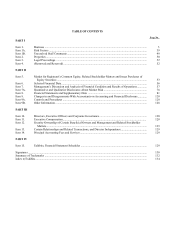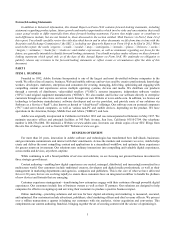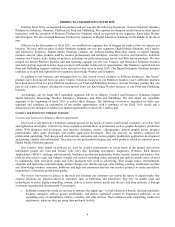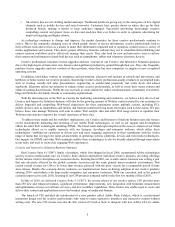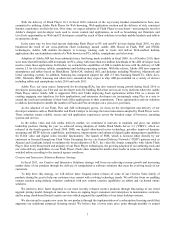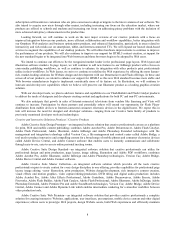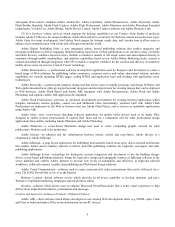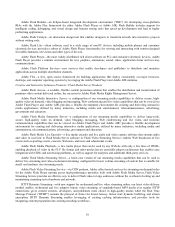Adobe 2010 Annual Report Download - page 6
Download and view the complete annual report
Please find page 6 of the 2010 Adobe annual report below. You can navigate through the pages in the report by either clicking on the pages listed below, or by using the keyword search tool below to find specific information within the annual report.6
services, which are a set of capabilities that enhance the feature set of Creative Suite to include features such as Adobe
BrowserLab, Adobe CS Review, SiteCatalyst NetAverages, Acrobat.com, and Adobe Story.
As of the end of fiscal 2010, we experienced an increase in revenue for CS5 when compared to a similar period of
availability for CS4. Despite this success, we did experience modest weakness in the adoption of CS5 in the second half of
fiscal 2010 in the education and Japan markets. We attribute this weakness to education budget issues which occurred during
the normally seasonally strong education buying period in the summer, and, economic weakness in the Japan market,
respectively. Overall, however, we believe CS5 has performed well given the status of the economy in our major markets
across the world.
During fiscal 2010 in the professional page layout market, despite the 2009 downturn in the economy and the financial
pressure facing traditional print media companies, we continued to focus on gaining market share during the year with our
Adobe InDesign product. Similarly, in the Web layout and Web development markets, and in the illustration market, we
focused on maintaining market share leadership with our Adobe Dreamweaver and Adobe Illustrator products. New CS5
versions of these products delivered in fiscal 2010 increased these products’ capabilities and value propositions for end users,
allowing us to maintain or grow our market share position against competitors.
In the fall of 2010 we introduced a beta of the Adobe Digital Publishing Suite, an online, hosted publishing solution that
enables magazine and newspaper publishers to deliver engaging, branded reading experiences of their publications to an
extensive array of mobile and tablet devices. This new solution combines hosted services, flexible e-commerce models to sell
single issues and subscriptions directly to consumers through mobile marketplaces, and analytics capabilities based on our
Adobe Online Marketing Suite. Content is created and enhanced through integration with CS5 to enable a complete workflow
for the creation and delivery of content to mobile device users via our new Content Viewer technology.
As hundreds of millions of people around the world adopt Internet-connected smartphones and tablet devices as a means
to communicate, collaborate and be entertained, as well as consumer electronic devices such as digital cameras, Internet-
connected televisions and game consoles, we believe a significant opportunity exists to offer more integrated solutions
involving our creative solutions and our platform technologies. This trend equally applies to emerging categories such as
smartphone and tablet application development, and user interface and application creation for new Internet-connected
televisions. The explosion in adoption of such devices is creating a challenge for content owners and application developers
to deliver consistent experiences across multiple devices, operating systems, Web browsers and screen sizes.
To address these challenges, we increased our investment during the year in support of formats and standards such as
HTML and Adobe Flash. During fiscal 2010, we introduced new features across many of our products to support the newest
version of the HTML standard, version 5 (“HTML5”). Among the new innovations we introduced were HTML5 feature sets
in our Dreamweaver and Illustrator products.
We also advanced the capabilities of our Adobe Flash Player during the year. In the later part of fiscal 2009 and during
the first half of fiscal 2010, we released a version 10.1 update for our Flash Player. For the first time, we simultaneously
delivered comparable Flash Player capabilities for both PC and non-PC implementations. Building upon the success of Flash
Player 10, the newest 10.1 version adds improved video capabilities such as HTTP streaming, content protection, peer-to-
peer support, and enhanced digital video recorder capabilities such as pause, instant replay, and slow motion for both PC as
well as smartphone and tablet environments. It also adds hardware acceleration for improved performance in both PC and
non-PC environments, and new user interface capabilities such as touch screen input methods for non-PC devices which lack
the traditional input methods of a PC such as a mouse.
Adoption of the new Flash Player 10.1 on PCs was the fastest ever of any Flash Player release during the three months
after it was commercially available. With non-PCs, companies such as Google, Research in Motion (“RIM”), Samsung and
Motorola announced or introduced Flash Player 10.1 as part of their new smartphone operating system and handset offerings
during the year. With this broad support, more than 10 million copies of Flash Player 10.1 for mobile devices were either
shipped or downloaded during fiscal 2010 and we expect approximately 60 million more shipments and downloads of Flash
Player to smartphones and tablets during fiscal 2011. This adoption of our Flash technologies resulted in strong growth in the
number of developers in the world who utilize our developer tools to deliver content and applications based on Flash.
Due to the success and frequent electronic downloads of these client technologies, we generate revenue through OEM
relationships with companies such as Google, where we include their technologies as part of the download offerings of our
client technologies on PCs. In fiscal 2010, this download revenue grew when compared to fiscal 2009 and represented a
significant part of the overall revenue we reported in our prior Platform segment.


